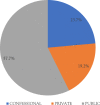Evaluation of emergency obstetric and neonatal care services in Kumba Health District, Southwest region, Cameroon (2011-2014): a before-after study
- PMID: 32046673
- PMCID: PMC7014610
- DOI: 10.1186/s12884-020-2774-9
Evaluation of emergency obstetric and neonatal care services in Kumba Health District, Southwest region, Cameroon (2011-2014): a before-after study
Abstract
Background: There is uncertainty regarding the status of emergency obstetric and neonatal care (EmONC) in the Cameroonian context where maternal and neonatal mortality are persistently high. This study sought to evaluate the coverage, functionality and quality of EmONC services in Kumba health district (KHD), the largest health district in Southwest Cameroon..
Methods: A retrospective study of routine EmONC data for the periods 1 January 2011 to 31 December 2012 (when EmONC was being introduced) and 1 January 2013 to 31 December 2014 (when EmONC was fully instituted) was conducted. Coverage, functionality and quality of EmONC services were graded as per United Nations (UN) standards. Data was analysed using Epi-Info version 7 statistical software.
Results: Among the 31 health facilities in KHD, 12 (39%) had been delivering EmONC services. Three (25%) of these were geographically inaccessible Among the 9 facilities that were assessed, 4 facilities (44%) performed designated signal functions, with 2 being comprehensive (CEmONC) and 2 basic (BEmONC). These exceeded the required minimum of 2.8 EmONC facilities/500000, 0.6 CEmONC facilities/500000 and 2.2 BEmONC facilities/500000, with reference to an estimated KHD population of 265,071. The signal functions that were least likely to be performed were neonatal resuscitation, manual evacuation of retained products and use of anticonvulsants. In 2011-2012, the facilities performed 35% of expected deliveries. This dropped to 28% in 2013-2014. Caesarean sections as a proportion of expected deliveries remained very low: 1.5% in 2010-2011 and 3.6% in 2013-2014. In 2011-2012, met needs were 6.8% and increased to 7.3% in 2013-2014. Direct obstetric fatality rates increased from 8 to 11% (p = 0.64). Intrapartum and very early neonatal deaths increased from 4.% to 7 (p = 0.89).
Conclusion: Major gaps were observed in the performance of signal functions as well as the quality and utilization of EmONC. While the results of this study seem to indicate the need to sustainably scale up the utilization of quality EmONC, the interpretations of our findings require consideration of improvements in reporting of mortality data associated with the introduction of EmONC as well as dynamics in country-specific maternal health policies and the potential influence of these policies on EmONC indicators.
Keywords: Availability; Care; Emergency; Neonatal; Obstetric; Quality; Utilization.
Conflict of interest statement
The authors declare that they have no competing interests.
Figures




Similar articles
-
Emergency obstetric and neonatal care availability, use, and quality: a cross-sectional study in the city of Lubumbashi, Democratic Republic of the Congo, 2011.BMC Pregnancy Childbirth. 2017 Jan 19;17(1):40. doi: 10.1186/s12884-017-1224-9. BMC Pregnancy Childbirth. 2017. PMID: 28103822 Free PMC article.
-
Signal functions for emergency obstetric care as an intervention for reducing maternal mortality: a survey of public and private health facilities in Lusaka District, Zambia.BMC Pregnancy Childbirth. 2017 Sep 6;17(1):288. doi: 10.1186/s12884-017-1451-0. BMC Pregnancy Childbirth. 2017. PMID: 28877675 Free PMC article.
-
Geographical distribution of emergency obstetric and neonatal care signal functions in Ethiopian health facilities: 2021-2022 Ethiopian service Provision Assessment (SPA).BMC Health Serv Res. 2024 Apr 2;24(1):409. doi: 10.1186/s12913-024-10893-5. BMC Health Serv Res. 2024. PMID: 38566163 Free PMC article.
-
A scoping review, mapping, and prioritisation process for emergency obstetric and neonatal quality of care indicators: Focus on provision and experience of care.J Glob Health. 2023 Oct 13;13:04092. doi: 10.7189/jogh.13.04092. J Glob Health. 2023. PMID: 37824168 Free PMC article.
-
Triangulating data sources for further learning from and about the MDSR in Ethiopia: a cross-sectional review of facility based maternal death data from EmONC assessment and MDSR system.BMC Pregnancy Childbirth. 2020 Apr 9;20(1):206. doi: 10.1186/s12884-020-02899-8. BMC Pregnancy Childbirth. 2020. PMID: 32272930 Free PMC article. Review.
Cited by
-
The increasing use of the WHO Safe Childbirth Checklist: lessons learned at the Yaoundé Gynaeco-Obstetric and Paediatric Hospital, Cameroon.BMC Pregnancy Childbirth. 2021 Jul 8;21(1):497. doi: 10.1186/s12884-021-03966-4. BMC Pregnancy Childbirth. 2021. PMID: 34238244 Free PMC article.
-
Effective Coverage of Emergency Obstetric and Newborn Care Services in Africa: A Scoping Review.Open Access Emerg Med. 2023 Apr 24;15:93-108. doi: 10.2147/OAEM.S403145. eCollection 2023. Open Access Emerg Med. 2023. PMID: 37124662 Free PMC article.
-
The Effectiveness of Regionalization of Perinatal Care and Specific Facility-Based Interventions: A Systematic Review.Neonatology. 2025;122(Suppl 1):245-261. doi: 10.1159/000541384. Epub 2024 Nov 6. Neonatology. 2025. PMID: 39504943 Free PMC article.
-
Evaluating the implementation fidelity of basic emergency obstetrics and neonatal care services in Beyeda District, Northwest Ethiopia: a case study evaluation.Front Glob Womens Health. 2024 Sep 3;5:1418338. doi: 10.3389/fgwh.2024.1418338. eCollection 2024. Front Glob Womens Health. 2024. PMID: 39290952 Free PMC article.
-
Barriers experienced by community midwives to provide basic emergency obstetric and newborn care in rural Pakistan.BMC Health Serv Res. 2023 Nov 27;23(1):1305. doi: 10.1186/s12913-023-10273-5. BMC Health Serv Res. 2023. PMID: 38012758 Free PMC article.
References
-
- Alkema Leontine, Chou Doris, Hogan Daniel, Zhang Sanqian, Moller Ann-Beth, Gemmill Alison, Fat Doris Ma, Boerma Ties, Temmerman Marleen, Mathers Colin, Say Lale. Global, regional, and national levels and trends in maternal mortality between 1990 and 2015, with scenario-based projections to 2030: a systematic analysis by the UN Maternal Mortality Estimation Inter-Agency Group. The Lancet. 2016;387(10017):462–474. doi: 10.1016/S0140-6736(15)00838-7. - DOI - PMC - PubMed
-
- World Health Organization. Trends in Maternal Mortality: 1990–2013; Estimates by WHO, UNICEF, UNFPA, The World Bank and the United Nations Population Division. Geneva: WHO; 2014.
-
- Hogan Margaret C, Foreman Kyle J, Naghavi Mohsen, Ahn Stephanie Y, Wang Mengru, Makela Susanna M, Lopez Alan D, Lozano Rafael, Murray Christopher JL. Maternal mortality for 181 countries, 1980–2008: a systematic analysis of progress towards Millennium Development Goal 5. The Lancet. 2010;375(9726):1609–1623. doi: 10.1016/S0140-6736(10)60518-1. - DOI - PubMed
-
- World Health Organization. Trends in Maternal Mortality: 1990–2015; Estimates by WHO, UNICEF, UNFPA, The World Bank and the United Nations Population Division. Geneva: WHO; 2015.
Publication types
MeSH terms
LinkOut - more resources
Full Text Sources
Medical
Miscellaneous

